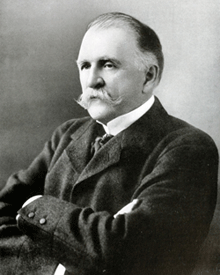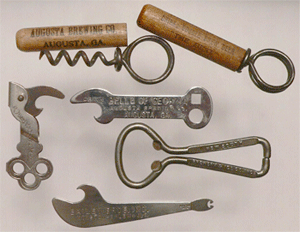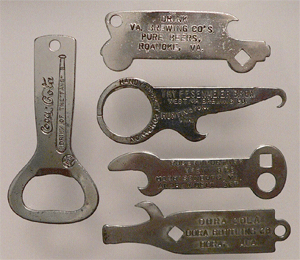|
Just For Openers from 1892 to the Present
A short history of bottle openers
By John Stanley
Posted November 2015

Who would have thought after William Painter invented the crown cap opener in 1892 that almost 125 years later thousands of different bottle openers would be patented for use in opening bottles? Every shape and size has been developed for use in a process that almost everyone takes for granted. Only when a person most needs a bottle opener do they appreciate the importance of this invention.
After Painter’s 1892 invention, crown caps became a staple for enclosing the contents of a bottle. By the time of National Prohibition in 1920, the U. S. had thousands of breweries big and small across the country. Many of these businesses had a bottle opener manufactured with their brewing or brand name on it to be given away in bars, saloons, fairs or whatever functions where groups of people met.
|

In addition to the crown bottle cap and opener, William Painter (Nov. 20, 1838-July 15, 1906) also held patents on 83 other inventions, including machines for capping bottles, folding paper, and detecting counterfeit money. He is in the Inventor Hall of Fame.
|
Early bottle openers were mainly in three groups, consisting of flat figural, key-shaped and cast iron. There were also many different novelty-type openers outside of these three groups. In addition, since the 1870s many drink establishments sealed their bottles with corks. A wide range of different corkscrews could also be found to uncork bottles.
|

|
Top pair: two wooden sleeve corkscrews from Augusta Brewing Co. of Augusta, Ga., ca. 1900-1910 ($100-$150 each). Middle: Belle of Georgia key-style opener from Augusta Brewing, ca. 1900-1910 ($150-$200). Left: Chattanooga Brewing folding key-style, ca. 1900-1910 ($250-$300). Bottom two: New South Brewery & Ice wire opener from Middlesborough, Ky., ca. 1910-1920 ($40-$60), and a pipe-shaped opener from Winston-Salem, N. C. advertising “Moonshine Smoking Tobacco” on back side, ca. 1915-1920 ($50-$75).
|
Many southern breweries had gone out of business by 1920 as the South passed laws to prohibit the sale of alcohol in their states, such as Tennessee in 1909. However, opener manufacturers of the period did not have to worry as soda was just as popular as beer across the country. Led by Coca-Cola, Pepsi-Cola and Dr. Pepper had bottling plants nationwide, and the bottled soda they produced required an opener of some form.
When Prohibition ended in 1933, openers for all kinds of beverages were needed in mass quantities. By this time, opener styles were concentrated in three styles: flat figural, key-shaped and now wire openers. Wire openers were the cheapest and easiest to produce.
In 1935, Krueger beer became the first canned beverage. This type of container required a triangular punch be made in the top of the container. The first can piercer was a thick steel opener and was made by Vaughan of Chicago and the American Can Company (Canco).
The onset of World War II saw major cutbacks in items produced with steel. Many openers that were made up until this time ended up in war drive scrap steel piles. Once WWII ended, opener production again picked up steam with the main types produced being wire openers and can piercers. The 1950s were the heyday of can piercers with almost every beverage producing some type of can piercer.
|

|
Top to bottom: Car-shaped bottle opener from Virginia Brewing Company of Roanoke, Va., ca. 1910-1920 ($150-$200); key-style opener with a button hook from West Virginia Brewing Company of Huntington, ca. 1905-1910 ($150-$200); key-style opener for Robert Portner Brewing’s agent in Harrisonburg, Va., ca. 1900-1920 ($75-$100); and bottle-shaped opener for Dora Cola of Dora, Ala., ca. 1915-1930 ($40-$50). Left side: Coca-Cola opener with a ball bat and baseball, ca. 1925-1940 ($250-$300).
|
Ermal Fraze invented the pop-top beer can in 1959, and by the mid-1960s, can piercers were no longer needed. You could open a can without needing an opener device. Bottled beer and soda still required an opener, and wire openers continued to be produced in large quantities. One issue with pop-top cans was that the person could choke on the pop tab if it was dropped into the can. By the 1970s, a push-tab can developed by Coors solved this problem.
By the 1970s, opener production was mainly confined to the major brewery and soda producers. The last 20 years have seen a shift again, and especially the last few years, as micro breweries have opened everywhere across the country. Hundreds of new opener styles have been made, and the number keeps rising. No matter how hard container producers try, many beverage manufacturers like a container that requires an opener.
As of 2015, the Just For Openers club has almost 2,000 different beer opener styles listed in the club Handbook of Beer Advertising Openers and Corkscrews. Soda styles at this time number in the 300-400 range for different types. For the most part, any person can start an opener collection with little effort, and most openers can be bought for under $20.
Early opener manufacturers were: William Rockwell Clough of Alton, N. H.; William Painter’s Crown, Cork & Seal Co. of Baltimore, Md.; Harry L. Vaughan’s Crown, Throat & Opener Co. of Chicago, Il.; John L. Sommer Mfg. Co. of Newark, N. J.; Augustus W. Stephens Mfg. Co. of Waltham, Mass.; Edwin Walker (Erie Mfg. Co.) of Erie, Pa.; and C. T. Williamson Wire Novelty Co. of Newark, N. J. These companies were prominent through Prohibition in 1920.
At that point, the Crown, Throat & Opener Co. became the Vaughan Novelty Mfg. Co. and dominated opener manufacturing until its closure in 1984. Vaughan was joined in the 1950s and 1960s by Handy-Walden Co. of Cambridge, Mass. Handy-Walden was a huge producer of the common can piercer (along with Vaughan). Currently, many opener manufacturers exist all over the world. Brown Manufacturing Co. of Decatur, Ga., continues to make Starr wall-mount bottle openers that were first produced in 1925.
When looking for openers, values can vary greatly. Even for Pre-Pro openers (made before 1920), the value can go from $2-$200 for key-style openers. The value almost always depends on the brewery or soda advertising on the opener. Condition, scarcity and style can play a major part also. The best outlet to buy openers is eBay. If nothing else, one can study that site to at least get a good feel for what openers sell for.
Opener collecting can be a very satisfying hobby and for the most part, is not too expensive.
------------------------------------
John Stanley is the editor of the Just For Openers newsletter. For more information on collecting bottle openers and corkscrews, visit the Just For Openers website at www.just-for-openers.org. Just For Openers was founded in 1978 by Don Bull and currently has 250 members from the United States and Canada. Membership is free if the newsletter is viewed on the website. JFO has an annual spring convention each year. This year’s convention is in Phoenix, Az. Recent conventions have been in Chapel Hill, N.C., Nashville, Tenn., Las Vegas, Nev., and Cedar Rapids, Ia.
|